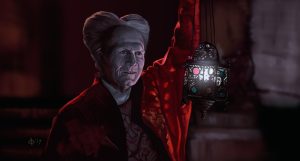
World Dracula Day: May 26
Every year, World Dracula Day is on May 26. (Though Dracula should really get his own night, not day, right?) True to his undead nature, the character lives on and on in movies, books, and other media, not passing away or even aging, perpetually sustained by the lifeblood of new inspiration and interpretation.
The character of a vampiric Count Dracula was created by the Irish writer Bram Stoker. He introduced Dracula to the world with his 1897 horror novel (published on May 26), a landmark of Gothic literature.
Since then, Dracula has appeared in countless other works of literature, such as Elizabeth Kostova's The Historian and Kim Newman's Anno Dracula series, as well as in movies, such as the 1931 Dracula starring Bela Lugosi and a recent three-part BBC miniseries. (My two favorite interpretations of Dracula in movies would be Gary Oldman's portrayal in Francis Ford Coppola's 1992 film, and Klaus Kinski's portrayal in Werner Herzog's Nosferatu the Vampyre from 1979.)

Why so compelling?
What is it about the character of Count Dracula that is so compelling, that stirs so much ongoing interest? Different writers, directors, and actors have seen different things in Dracula as the decades have gone by: a cruel monster, a handsome seducer, a misunderstood recluse, a lonely creature cut off from human society, perhaps punished for his evil nature.
Certainly, Dracula represents something otherworldly, and yet many of us can relate to certain aspects of him since he's at once a strange and powerful being and yet, in essence, very human.

Dracula, the Undead
The crucial aspect of Dracula is that he is undead, outside the common and familiar human experiences of birth, growth, aging, and death. He's forever trapped between being and non-being, always dependent on the blood of the living, unable to escape this constant need. He is immortal and has certain unusual powers and weaknesses that no other being possesses, symbolizing how far he is removed from human society and even from the passage of time.
Dracula seems to capture many contradictions and can be the object of awe, horror, and pity, sometimes all at once. While the well-known Dracula of popular culture and Halloween-time was defined by Bela Lugosi's performance, there have been various portrayals and interpretations of Dracula over the years as either handsome or ugly, debonair or awkward, retiring or bold, sinister or more humorous, alien or intensely human.
For example, Bela Lugosi's Dracula is urbane and aristocratic (and a little campy), while Klaus Kinski's is quiet, pained, and sorrowful. Claes Bang's Dracula has an assured, smug sense of humor, Frank Langella's Dracula is elegant and seductive, and Gary Oldman's is passionate, grim, and obsessed. I can't think of another fictional character who's been interpreted in so many different ways as time has passed, culture changes, and new artists have brought their creative powers to shape our understanding of that figure. Truly, Dracula in his essence is still very much a mystery, and this is what has allowed him to remain so vital and fascinating over so long a time.


Add a comment to: World Dracula Day